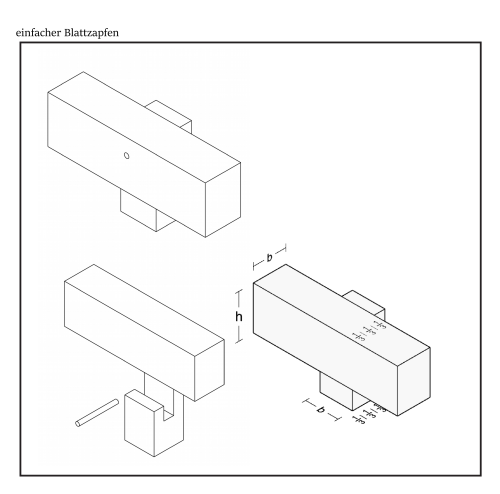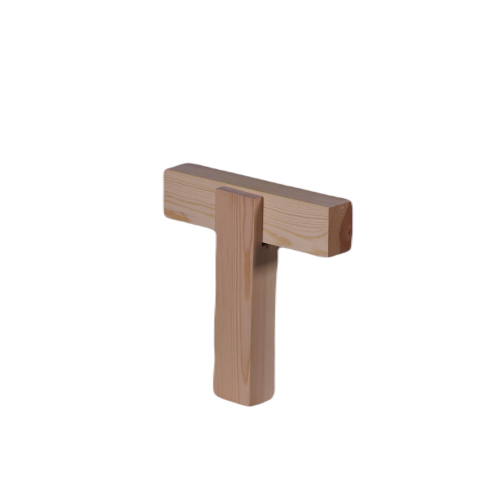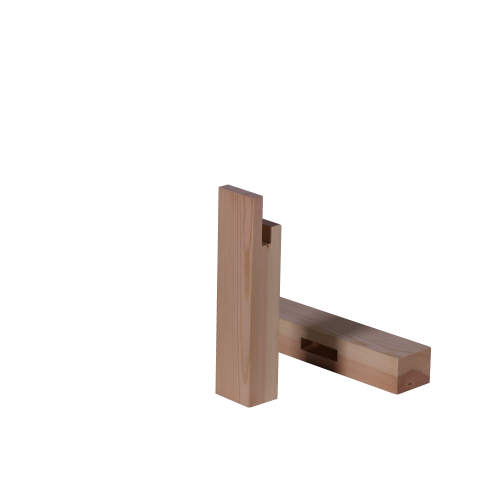leaf tenon
This connection is especially found in half-timbered construction. The simple non-flush leaf tenon is a mixture of a leaf and a tenon and combines their advantages. The leaf and tenon should each be a quarter of the timber width. The tenon should be at least 4-6 cm long and the length of the leaf should be adapted to the height of the continuous beam. The joint is secured with a split pin, which is pushed through the leaf and the tenon. The arrangement of the joined components additionally protects the spigot against water penetration. Compressive, tensile and shear forces can be absorbed (cf. Gerner, 1992, p. 113).
Mortise and tenon joints
Along with leaves, tenon joints are one of the oldest and most widespreada types of wood joint. The developmental stages of the tenon can hardly be traced, but it is certain that at the latest in 3000 BC wooden joints were made in the form of "insertion holes". Tenons for doors and gates were already known (cf. Gerner, 1992, p. 53). Due to the universal usability of tenons, they contribute decisively to constructive solutions and even make them possible. Thus, the mortise and tenon, a mortise and tenon that is secured with wedges or split pins, is considered the basis and most important element of all house frames and anchor beam constructions. For some constructions, the mortise and tenon joint is already considered the constructive basis at that time (cf. Gerner, 1992, p. 53).
Neck joint
In neck joints there are no longitudinal joints and no corner joints. The origin of the neck joint is the branch fork on a post or a stud in which a horizontal timber such as a ridge, middle or foot purlin (a horizontal beam in the roof construction) rests, whereby the joint is already relatively secure without additional fasteners due to the load alone (cf. Gerner, 1992, p. 135).
Besonders im Fachwerkbau ist diese Verbindung zu finden. Der einfache nicht bündige Blattzapfen ist eine Mischung aus einem Blatt und einem Zapfen und vereint deren Vorteile. Blatt und Zapfen sollen hierbei jeweils einem Viertel der Holzbreite betragen. Der Zapfen ist 4-6 cm Mindestlänge auszuführen und das Blatt passt sich von der Länge der Höhe des durchlaufenden Balkens an. Gesichert wird die Verbindung mit einem Splint, der durch das Blatt und den Zapfen geschoben wird. Durch die Anordnung der Gefügten Bauteile wird der Zapfen zusätzlich gegen eindringendes Wasser geschützt. Es können Druck-, Zug- und Scherkräfte aufgenommen werden (vgl. Gerner, 1992, S. 113).
Zapfenverbindungen
Zapfenverbindungen gehören neben Blättern zu den ältesten und weitest verbreitetena Holzverbindungsarten. Die Entwicklungsstufen des Zapfens sind kaum nachzuvollziehen, jedoch steht fest, dass spätestens 3000 v. Chr. Holzverbindungen in Form von „Einsatzlöchern“ ausgeführt wurden. Bekannt waren bereits auch Drehzapfen für Türen und Tore (vgl. Gerner, 1992, S. 53). Durch die universelle Verwendbarkeit von Zapfen tragen diese entscheidend zu konstruktiven Lösungen bei und ermöglichen diese sogar. Somit gilt das Zapfenschloß, ein durchgesteckter Zapfen der mit Keilen oder Splinten gesichert wird, als die Basis und wichtigstes Element aller Hausgerüste und Ankerbalkenkonstruktionen. Für einige Konstruktionen gilt schon damals das Zapfenschloss als die konstruktive Basis (vgl. Gerner, 1992, S. 53).
Halsverbindung
Bei Halsverbindungen gibt es keine Längs (I)- und keine Eckverbindungen (L). Der Ursprung der Halsverbindung ist die Astgabel auf einem Pfosten oder einem Ständer, in welche ein waagerechtes Holz wie First-, Mittel-, oder Fußpfette (ein waagerechter Träger in der Dachkonstruktion), aufliegt wodurch bereits ohne zusätzliches Verbindungsmittel allein durch die Auflast die Verbindung relativ sicher ist (vgl. Gerner, 1992, S. 135).




